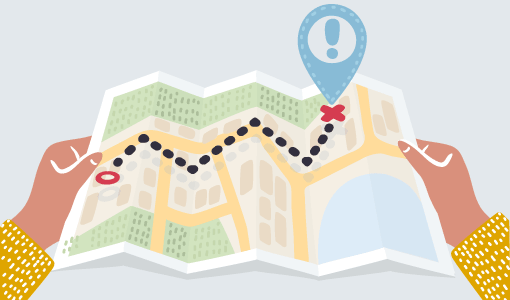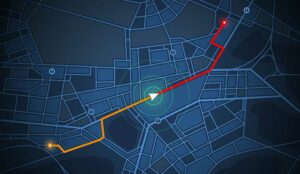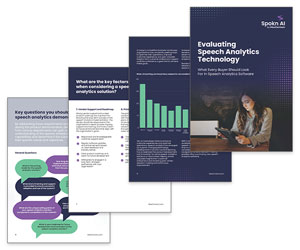We define customer journey analytics and examine how it can be such a powerful tool in terms of improving customer experience.
A Definition of Customer Journey Analytics
Customer journey analytics is the process of analysing how customers are interacting with your organization.
This includes looking for trends in which channels customers use to interact with you when they come across different issues.
Customer journey analytics also identifies how your customers move across different channels and touchpoints…
But it’s not limited to that. Customer journey analytics also identifies how your customers move across different channels and touchpoints, throughout their entire customer experience. This is where things get a little more tricky.
While contact centre reporting can help you to analyse which channels customers use for certain issues, to get a full picture of how customers move across channels, specialist customer journey analytics software can provide further help.
Why Are Organizations Using Customer Journey Analytics?
As the hype around customer experience has grown, so has the interest within the field of customer journey analytics.
Organizations are trying to unite each department, using customer journey maps as a diagnostic tool.
Organizations are trying to unite each department, using customer journey maps as a diagnostic tool.
For many, the focus has therefore shifted to creating a shared, unified view of the customer and measuring the journey across the whole customer experience.
By observing how customers interact with us, from the first point of their journey until the last, we can spot trends in customer behaviour – allowing us to:
- Find areas to improve customer experience
- Increase operational efficiency and make it easier for customers to switch between channels
- Spot trends that lead to customer churn and try to prevent this
- Look for opportunities to increase revenues
But where can you begin when trying to achieve each of these outcomes?
It All Starts With a Customer Journey Map
To analyse your customer journey, you need to know your key customer touchpoints.
In order to do this, it is best to map out your customer journey in an exercise that includes each department within your organization.
Once you have done this, you can determine how you gather data at every touchpoint of the journey – remembering that each touchpoint can influence the customer’s decision-making.

You can determine how you gather data at every touchpoint of the journey – remembering that each touchpoint can influence the customer’s decision-making.
By creating a customer journey map, you have the perfect platform to get going with customer journey analytics.
Other customer journey analytics best practices include:
Create Personalized Experiences – Customer journey analytics can tell us how a certain type of customer is likely to react in a given situation. This presents us with an opportunity to personalize their experience, to increase satisfaction levels.
Don’t Look to Justify Biases – There will always be reasons behind the data found in customer journey analytics, but we shouldn’t look at this data as a way to confirm our preconceptions. Analytics is not the same as storytelling.
Keep Listening to Customers – While journey analytics will allow you to spot trends, don’t act on that data until you talk to customers and advisors. They may be able to suggest reasons for the trend that you may not have otherwise considered.

Morris Pentel
By following this advice, you can start creating improvements in your contact centre, based on access to much more insight.
“You will see the customer journey end to end as silos of data will start to merge together, giving agents more insight to give higher-value outcomes,” says Morris Pentel, the Chairman of The Customer Experience Foundation.
“This insight must be driven for contact centres who already have access to the tools and are able to increase the value of agents by listening to calls.”
Find out how to design a customer journey map by reading our article: 5 Steps to Creating a Customer Journey Map
5 Types of Customer Journey Analytics
By analysing the customer journey, we can assess how customers move from one touchpoint to another. But there are multiple ways in which we can do this.
Let’s say we have a specialized customer journey analytics system. We could undertake any of the following five types of analysis:
1. Comprehensive Analysis – This type of analysis allows us to take a look at the “bigger picture”, revealing the great variety of routes that customers take across our communication channels.
With this analysis, we can identify the most significant channels and we can measure their impact on the wider business in different ways.
2. Priority Analysis – Customer journey analytics of this kind enables us to discover which journeys are most important in terms of generating revenue and satisfaction.
With this knowledge, we can prioritize these journeys and also consider how we can better utilize these journeys to engage with customers in a personalized way, at the right time and on the right channel.
Seeing how customer journeys change over time can prove to be an interesting exercise that allows us to identify real-time engagement opportunities.
3. Real-Time Analysis – Seeing how customer journeys change over time can prove to be an interesting exercise that allows us to identify real-time engagement opportunities.
These will ideally be driven by an understanding of customer behaviour – but having insights, in the moment, can enable us to do things like save customers from churning, before they have already done so.
4. Scaled Analysis – While we can look at the customer journey across the entire customer experience, we can scale customer journey analytics back and gather insights from macro-journeys, within individual departments.
Look at how a contact may travel through the contact centre, for instance. By doing so, we may find bottlenecks and insights into where customers bounce from one channel to another.
5. Narrative Analysis – Narrative analysis, where we construe stories from within the context of research, can be very interesting, so long as we don’t use customer journey analytics results only to look to confirm our preconceived ideas.
Forming data-driven narratives from hundreds or maybe even thousands of data points helps to remove a more subjective interpretation of what’s going on – especially when we use charts and graphs to highlight our findings.
7 Interesting Questions Customer Journey Analytics Can Answer
We introduced a few of the benefits of using customer journey analytics within our organization earlier, but the tool can provide us with many more interesting insights.
For example, by using any of the five types of customer journey analysis, we can answer complex questions like:
1. What percentage of our customers follow this journey?
This helps you to focus on the most important journeys first, so you can prioritize your customer journey improvements and get the most bang for your buck.
2. Which steps did our MOST satisfied customers take within this journey?
By knowing the route of optimal satisfaction within our journey, we can carefully place nudges within the customer experience in order to push more customers down that path.
3. Which steps did our LEAST satisfied customers take within this journey?
If we know which steps our least satisfied customers took, we can prioritize this as an area to address or suggest other options to customers, which will likely make them happier down the road.
4. Which type of customer is most likely to follow this journey?
Splitting your customer base into personas and identifying which journeys they take enables you to design a service proposition at key touchpoints that better suits the preferences of that persona type.
5. What is the best channel to interact with this type of customer?
Identifying the channel preferences of individual customers, through customer journey analysis, enables you to create rules in your customer journeys for how best to reach out to them.
6. When is the best time to connect with this type of customer?
Knowing the most effective time to connect with a customer enhances your chances of a good interaction with them. This should again be a rule that is built into your customer journeys.
7. Where can we add most value for the customer within this journey?
Customer journey analytics will tell us at what points we are already satisfying customers, which we can enhance to deliver a differentiated customer experience.
Find out how to deliver a differentiated experience by reading our article: 14 Ideas for Providing a Memorable Customer Experience
Where Can Customer Journey Analytics Fail?
To finish off, let’s take a look at some of the traps that are easy to fall into when using customer journey analytics.
If you get these things wrong, you can jump to the wrong conclusions in your analysis, meaning that you have a negative impact on customer experience.
Abandoning the Review Phase – Within any customer data analysis, there is an urge to be seen to do the right thing in terms of collecting and reporting on the data, but then we fail to take the time to properly review those findings.
However, when we do this, we fail to gather the customer experience insights, which is the entire point of using customer journey analytics in the first place.
Failing to Analyse Enough Data – We cannot come to conclusions without lots of data to support our argument, so thinking of how to extract data from key customer touchpoints – in a non-invasive way – is a key challenge.
Data integration can be difficult and time consuming – even if you have invested in specialist customer journey analytics software.
This challenge is not easy, as data integration can be difficult and time consuming – even if you have invested in specialist customer journey analytics software.
Ignoring Wider Trends in Our Analysis – When running customer journey analytics, it is easy to look for averages, such as “What is the average satisfaction rate at this particular customer journey?”
But we shouldn’t become fixated on these averages, as they might just be a single point in a trend with great variation.
Taking Too Much Time to Action Findings – Customer journey analytics often takes a long while to complete, as analysts will spend most of their time accumulating and cleaning the relevant data.
For many organizations, this can mean that it takes weeks, if not months, to find relevant insights, which can lead to problems because customer behaviour is now changing at an unprecedented pace.
Underestimating the Resources Required – Even after you have integrated your systems and have a clear flow of data, customer data analytics may still be a task for skilled data scientists.
Not only are these data scientists hard to hire, as highlighted in the previous point, it will take quite some time for them to ascertain significant finding that have the potential to improve customer experience.
For more on using analytics within the contact centre environment, read our article: An Introduction to… Contact Centre Analytics
For more on customer analysis in the contact centre and beyond, read our articles:
- 9 Ways to Analyse Customer Data
- 16 of the Best Uses for… Contact Centre Analytics
- 25 Tips for Effective Data Visualization
Author: Robyn Coppell
Published On: 7th Sep 2020 - Last modified: 21st Feb 2024
Read more about - Customer Service Strategy, Analytics, Customer Journey, Customer Management, Morris Pentel
















